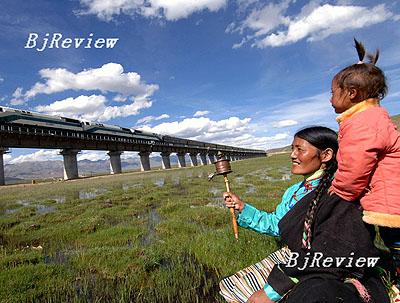
In an interview with Germany’s Der Spiegel magazine on March 26, 2007, the 14th Dalai Lama explained his view on the Tibet issue, disguising himself as an exile persecuted by the Chinese Government and a monk with no political ambitions. His words, it seems, are designed to deceive those who know little about the history of Tibet. Zuo Feng, a Chinese expert on ethnic affairs and official with the Information Office of the State Council, China’s cabinet, writes to Beijing Review and expresses his views on the issues of “greater autonomy” in Tibet, the protection of Tibetan culture and the role of the Qinghai-Tibet Railway in Tibet’s development, all of which the Dalai Lama mentioned in his interview .
‘Greater Tibet’ is historically baseless
The Dalai Lama told Der Spiegel that his foremost objective is to protect Tibetan culture and the status of Tibet. By “Tibet,” he does not mean the current Tibet Autonomous Region, but a “greater Tibet” that covers the 6 million Tibetan people. According to the Dalai Lama, only the acceptance of his idea of “greater autonomy” in Tibet and the Tibetan habitats in provinces neighboring the Tibet Autonomous Region can show the Chinese Government’s recognition of and respect for the original state of the Tibetan people. He condemns the Central Government for dividing Tibet and incorporating different parts of Tibet into other provinces. Is there any truth to this? Those who have some knowledge of Tibetan history will know that after the disintegration of the Tubo Dynasty in the ninth century, there has never existed a unified political entity known as “greater Tibet.” In the Yuan Dynasty (1206-1368), local military and administrative organs were set up under the name of the High Pacification Commissioner’s Office in the three major regions that are traditionally inhabited by the Tibetan people, including Ü-Tsang (most areas of today’s Tibet Autonomous Region), Amdo (the southern part of Gansu Province, Aba region in Sichuan Province and most of the Tibetan habitats in Qinghai Province) and Kham (Yushu region in Qinghai Province, Ganzi region in Sichuan Province, Diqing region in Yunnan Province and Qamdo region in Tibet Autonomous Region). This system serves as the base for the later administrative division of Tibet and other Tibetan habitats. The Ming Dynasty (1368-1644) inherited the system of the Yuan Dynasty. In the Qing Dynasty, with the support of the Central Government, the Fifth Dalai Lama established a Tibetan local government. Later, on the basis of the old administrative division, the boundaries between Tibet and its surrounding provinces including Gansu, Qinghai, Sichuan and Yunnan were further demarcated. That is to say, Tibetan habitats outside Tibet have never come under the jurisdiction of the Tibetan local government and thus there is no historical basis for the so-called “greater Tibet.”
For thousands of years, China’s 56 ethnic groups have been living together. A prominent feature of the country’s ethnic population distribution is that an ethnic group may inhabit various administrative areas, while an administrative area may be home to a variety of ethnic groups living in compact communities or not. Throughout history, on one hand, the Tibetan people have shared the same ethnic characteristics, especially in terms of religion and culture, despite living in different areas; on the other hand, there also exist differences in the language and customs even within the Tibetan people. At the same time, Tibetan people scattered in different areas have frequent communication with other ethnic groups, enjoying close economic links. Since the People’s Republic of China was founded in 1949, besides the Tibet Autonomous Region, eight Tibetan autonomous prefectures, one Tibetan-Qiang autonomous prefecture, one Mongolian-Tibetan autonomous prefecture and two Tibetan autonomous counties have been set up. In some Tibetan autonomous prefectures there are also autonomous counties of other ethnic groups. This pattern of administrative division is based on historical characteristics of the country’s ethnic group distribution and also takes into full consideration the long-term development, ethnic, political, regional and economic factors. Such a pattern will encourage people of all ethnic groups to work hard together for the common prosperity of the country.
Therefore, the so-called “greater Tibet” peddled by the Dalai Lama is not only baseless, but also goes against the internal law of China’s ethnic group development.
Is there a ‘cultural homicide’ in Tibet?
In the interview, the Dalai Lama said it is his moral responsibility to seek overall protection of Tibetan culture, labeling himself as a real cultural guardian. How factual is this? Before 1956, when Tibet was under the rule of the Dalai Lama, means of production, culture, art and educational opportunities were preserved to a small group of monks and nobles, while the serfs, who made up 95 percent of Tibet’s population, lived in extreme poverty, with basic life necessities difficult to find, let alone the opportunity of education. At that time, the illiteracy rate of the Tibetan people stood at 95 percent. The longstanding feudal serf system based on the combination of religion and politics not only severely restricted productivity in Tibet, but also left Tibet’s traditional culture, such as ancient relics and places of interest, in a state of disrepair. There were no opportunities for the development of science and technology.
|
